 Image search results - "weeping" Image search results - "weeping" |

Chiba Park approach
|
|
|

White weeping cherry blossoms
|
|

White weeping cherry blossoms
|
|

Pink weeping cherry blossoms
|
|
|
|
|
|
|
|
|

White and pink weeping cherry blossoms
|
|

About 30 weeping cherry trees ring the pond's perimeter.
|
|

Chiba Park
|
|
|
|
|
|
|

Weeping cherry
|
|

Most of the weeping cherries are planted along the pond's edge.
|
|

Weeping cherry next to the water park.
|
|

Chiba Park weeping cherries
|
|

Weeping cherries
|
|

Boats for rent
|
|
|
|
|

Hitsujiyama Park with weeping cherry blossoms and Mt. Bukosan. 羊山公園
|
|
|

Hitsujiyama Park with weeping cherry blossoms
|
|
|

Hitsujiyama Park and Mt. Bukosan.
|
|
|
|
|
|
|

Chiba Park
|
|

Weeping cherry tree
|
|
|

Weeping cherry tree, Koishikawa Korakuen Garden, Tokyo. 枝垂桜
|
|

Monorail track
|
|

This weeping cherry tree is about 60 years old.
|
|
|

Weeping cherry tree, Koishikawa Korakuen Garden, Tokyo.
|
|
|

Weeping cherry tree, Koishikawa Korakuen Garden, Tokyo. Called "Shidare-sakura" in Japanese meaning cherry tree with drooping branches.
|
|
|

With Tokyo Dome looming above, Koishikawa Korakuen is another famous Edo-Period Japanese garden originally built by Lord Yorifusa of the Mito Tokugawa Clan in 1629 as part of his Edo estate.The garden was completed under Lord Mitsukuni, the second lord of the Mito clan.
|
|
|
|
|
|
|
|

Shorozan hill 小廬山
|
|

Arakiyama hill 荒木山A low hill is next to the pond. Some cherry trees are also on this hill.
|
|
|

Arakiyama hill 荒木山
|
|

Tokyo Dome in the background. The garden is right next to Tokyo Dome.
|
|

Photogenic weeping cherry シダレザクラ
|
|
|
|

Larger weeping cherry tree.
|
|

Weeping cherry tree is "shidare-zakura" in Japanese.
|
|
|

"Shidare" actually means "drooping."
|
|
|
|

Monument for the Ohga Lotus, a 2,000-year-old lotus flower species discovered in Chiba by the late Dr. Ohga in 1951. 大賀ハス
|
|

Weeping cherry tree, Koishikawa Korakuen Garden, Tokyo.
|
|

Lotus Pavilion, the Ohga Lotus blooms around this pavilion during June and July. 蓮華亭
|
|

Weeping cherries
|
|

Inside Lotus Pavilion, pictures of the Ohga Lotus is displayed. 蓮華亭
|
|

Weeping cherry tree and Tsutenkyo Bridge 通天橋
|
|

Pond path
|
|

綿打池
|
|

Large weeping cherry tree しだれ桜
|
|

綿打池
|
|
|

Chiba Koen Station 千葉公園駅
|
|

Chiba Koen Station monorail platform 千葉公園駅
|
|

Chiba Koen Station monorail
|
|
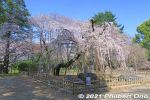
In spring, Guhoji's 400-year-old weeping cherry blossom tree is famous. 伏姫桜
|
|
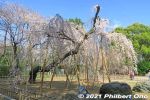
The weeping cherry tree looks different from different angles.
|
|
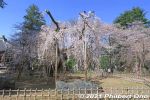
Guhoji's 400-year-old weeping cherry blossom tree is named "Fushihime Sakura." 伏姫桜
|
|
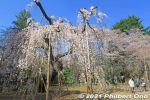
In Ichikawa, Chiba, Guhoji's 400-year-old weeping cherry blossom tree is named "Fushihime Sakura." 伏姫桜
|
|
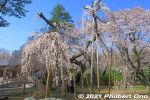
We can see that a few branches had been cut, which means the tree was larger.
|
|
|
|
|
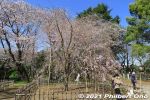
Another weeping cherry tree next to Fushihime Sakura.
|
|
|
|
|
|
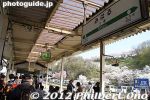
JR Miharu Station on the Ban'etsu-to Line, two stops from JR Koriyama Station on the Tohoku shinkansen line.
|
|

JR Miharu Station greets you with numerous cherry blossoms right along the tracks.
|
|
|
|
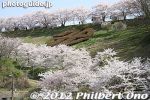
From JR Miharu Station, you can see these cherry blossoms.
|
|
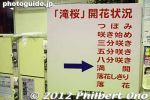
Inside Miharu Station is this sign indicating the status of the Miharu Takizakura weeping cherry tree. It points to "Full bloom."
|
|

JR Miharu Station
|
|
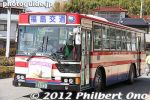
From JR Miharu Station, shuttle buses run to the Miharu Takizakura weeping cherry tree.
|
|
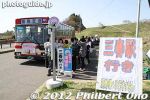
Shuttle bus stop near the Miharu Takizakura weeping cherry tree.
|
|

From the bus stop, follow the sign.
|
|
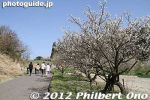
A short walk from the bus stop.
|
|
|
|
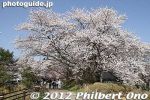
First you see some cherry trees along a ridge on a hill.
|
|
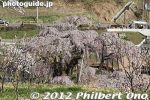
The granddaddy Miharu Takizakura weeping cherry tree is visible from the ridge.
|
|
|
|
|
|
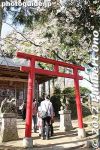
Inari Shrine on the ridge.
|
|
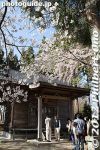
Inari Shrine
|
|
|
|
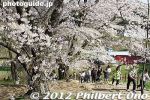
From the ridge, go down these steps to see the Miharu Takizakura weeping cherry tree on a slope.
|
|
|
|
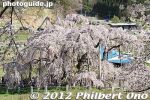
Miharu Takizakura weeping cherry tree.
|
|

The Miharu Takizakura (Waterfall cherry blossoms) cherry tree is one of Japan's most famous and grandest weeping cherry tree. It is over 1,000 years old and the mother of thousands of weeping cherry trees in Japan and even overseas.
|
|

The Miharu Takizakura weeping cherry tree is in a park-like area with walking paths.
|
|
|
|
|
|
|
|
|
|
|
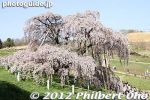
The Miharu Takizakura weeping cherry tree looks different from different angles.
|
|
|
|
|
|
|
|
|
|
|
|
|
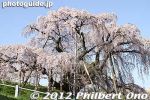
Miharu Takizakura weeping cherry tree in Miharu, Fukushima Prefecture. Over 1,000 years old.
|
|
|
|
|
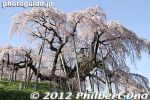
Miharu Takizakura weeping cherry tree in Miharu, Fukushima Prefecture. Over 1,000 years old.
|
|
|
|
|
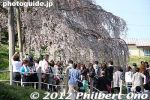
People are not allowed to walk on the tree roots so there is a walking path along the tree edge.
|
|
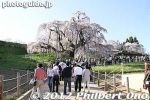
Going to the Miharu Takizakura weeping cherry tree in Miharu, Fukushima Prefecture.
|
|

A volunteer photographer will take your picture with your camera for free.
|
|
|
|
|
|
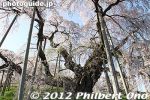
Miharu Takizakura weeping cherry tree in Miharu, Fukushima Prefecture. Over 1,000 years old.
|
|
|
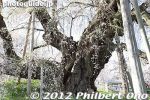
Many tree trunks are twisted together to form this one, large trunk.
|
|
|
|
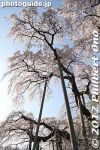
Wooden posts support the tall branches.
|
|
|
|
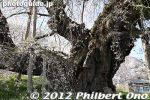
A gigantic bonsai tree.
|
|
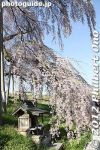
A little shrine under the Miharu Takizakura weeping cherry tree in Miharu, Fukushima Prefecture.
|
|
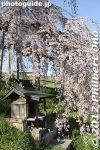
A little shrine under the Miharu Takizakura weeping cherry tree in Miharu, Fukushima Prefecture.
|
|
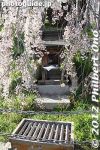
A little shrine under the Miharu Takizakura weeping cherry tree in Miharu, Fukushima Prefecture.
|
|
|
|
|
|
|
|
|
|
|
|
|
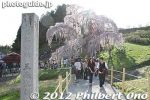
Miharu Takizakura weeping cherry tree in Miharu, Fukushima Prefecture.
|
|
|
|
|
|

Map of the area around the Miharu Takizakura weeping cherry tree in Miharu, Fukushima Prefecture.
|
|
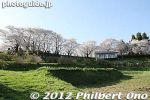
Cherry trees along the ridge of the hill.
|
|
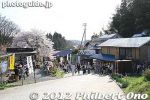
Souvenir shops are food stalls.
|
|
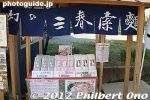
Sakura noodles.
|
|
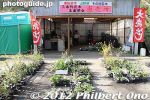
Plants for sale.
|
|
|
|
|
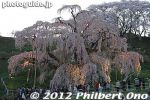
They turn on the lights at 6 pm when the tree is in bloom. But we had to wait about an hour before it got dark enough.
|
|
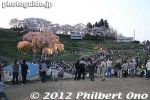
A large crowd even in the evening. Lotta photographers too.
|
|
|
|
|
|
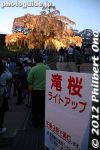
The Miharu Takizakura weeping cherry tree is lit up till 9 pm.
|
|
|
|
|
|
|
|
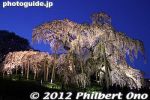
Miharu Takizakura weeping cherry tree in Miharu, Fukushima Prefecture.
|
|
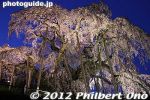
Miharu Takizakura weeping cherry tree in Miharu, Fukushima Prefecture.
|
|
|
|
|
|
|
|
|
|
|
|
|
|
|
|
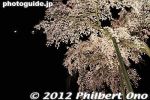
Moon
|
|
|
|
|
|
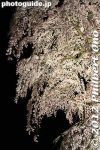
Hokusai-style cherry blossom waves.
|
|
|
|
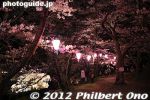
Back on the hilltop ridge. That's the Takizakura on the lower left.
|
|
|

Dairinji temple's weeping cherry tree.
|
|
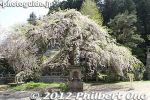
Dairinji temple's weeping cherry tree.
|
|
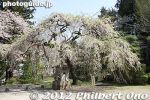
Dairinji temple's weeping cherry tree.
|
|
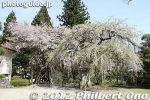
Dairinji temple's weeping cherry tree.
|
|

Map of Dairinji temple.
|
|
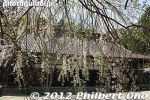
Dairinji temple.
|
|
|
|
|
|
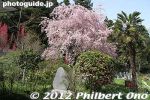
Dairinji temple.
|
|
|
|
|
|
|
|
|

A long line forms at Rikugien's Someimon Gate entrance. When the weeping cherry tree is in bloom in late March, many people come. 染井門
|
|

Even the main Seimon entrance is crowded with people. This is a weekday. Admission 300 yen. 正門
|
|

Seimon Gate entrance to Rikugien Garden.
|
|
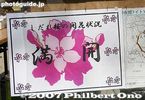
Sign says the weeping cherry tree is in full bloom (mankai). 「しだれ桜 満開」
|
|

Rikugien Garden's famous weeping cherry tree. In Japanese, it is called "shidare-sakura" meaning drooping cherry.
|
|

A large crowd admire the beautiful weeping cherry tree.
|
|

When this weeping cherry tree is in bloom, the garden is open at night and this tree is lit up.
|
|

Very difficult to take a picture of the tree without any people in it.
|
|

Rikugien is one of the nicest Japanese gardens in central Tokyo, and one of two of Edo's famous gardens (other is Koishikawa Korakuen). The garden was built in 1702 by Lord Yanagisawa Yoshiyasu from Kawagoe, who was a favorite ally of Shogun Tokugawa Tsunayoshi, the 5th Tokugawa Shogun. It is a Kaiyu-type (stroll around a central pond) Daimyo garden with hills and ponds. Near Komagome Station on the Yamanote Line.
|
|

Weeping cherry flowers.
|
|

Closeup of flowers.
|
|

Side view
|
|
|
|
|

Under the shower of weeping flowers.
|
|
|

Tree trunk
|
|
|

The many low-hanging branches are supported by wooden posts.
|
|

How the tree looks after it finishes blooming.
|
|

When the weeping cherry tree is in bloom, Rikugien Garden also illuminates the tree at night in late March to early April.
|
|

Very beautiful, but very crowded.
|
|
|
|
|
|

Picture-taking frenzy around Rikugien's weeping cherry tree.
|
|
|
|